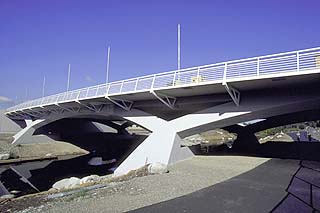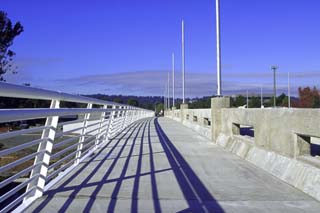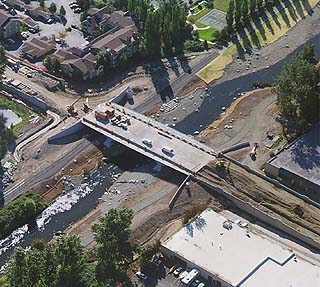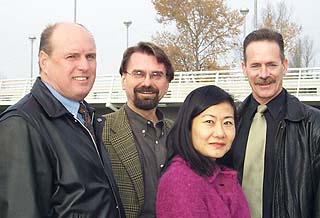|
Subscribe / Renew |
|
|
Contact Us |
|
| ► Subscribe to our Free Weekly Newsletter | |
| home | Welcome, sign in or click here to subscribe. | login |
Construction
| |
December 4, 2002
LMN's Redmond bridge turns mundane into magical
Special to the Journal

Photos by Vince Streano The bridge needed to accommodate expansion of a trail network that is becoming one of the attractions of the city. Space beneath the bridge had to be free of piers and columns that would block views and get in the way of pedestrians. |
A bridge can be a beautiful thing. But unless it spans a major waterway or serves pedestrians in a park setting, the typical bridge is easy to miss. All over the U.S., well-engineered concrete slabs get the job done, but they give no joy.
"With a lot of bridges, you go over it, and you didn’t even know you were on a bridge," said architect Walt Niehoff, who led the architectural design of Redmond’s new Northeast 90th Street Bridge.
He was very happy that his firm, LMN Architects, was invited by Entranco Engineers and the city of Redmond to help design a bridge over the tamed and neglected Sammamish River as it enters the northern edge of the growing city. "What a great experience for a city -- to have a river running through it."
Actually, the river itself was as straight as any street -- thanks to traditional Corps of Engineers flood control practices -- and overgrown with invasive blackberries. But over the last decade, a groundswell of awareness within city government and among the local business community made the river and its crossings an open question, and an opportunity to shape the future of the city.
|
Northeast 90th St. Bridge |
|
City of Redmond Architect: LMN Architects Project type: Transportation Project size: 220-foot bridge span Completion date: April 2001 Construction cost: $8.9 million Structural engineer: Entranco Landscape architect: Brumbaugh & Associates Geotechnical engineer: GeoEngineers Architectural lighting: Genette Beaudette General contractor: Atkinson Construction In a hardscape overrun with dismal concrete forms, this bridge is a welcome addition... a pleasing and graceful portal to Redmond. Redmond's Northeast 90th Street Bridge is an example of infrastructure that contributes to its setting -- it touches lightly on the landscape. |
Most of the bridges in Redmond were inherited from the county. As the city looks ahead, it has drawn on collective memories of beautiful bridges -- ones associated with great old cities or beautiful landscapes in far away places. In most cases, these classic bridges complete the scenery of an urban waterway, a river or mountain roadway, so that natural and man-made are more than the sum of the parts.
According to Dennis Brunelle, project manager for Redmond’s public works department, that’s exactly what the mayor, the council and city leaders had in mind when they decided to make an investment in the new bridge and spread the benefit to the whole community. This new bridge would be seen -- from near and far, from on top and below. It would be a gateway, landmark, a destination and a showpiece for Redmond.
Along with the expansion of Northeast 90th Street and the bridge, they also wanted to expand a trail network that is becoming one of the attractions of the city. Last but not least, planners wanted to improve the environment for fish, native plants and other wildlife.
Entranco, which had designed other bridges around Redmond, sought out LMN Architects and also teamed up with Brumbaugh and Associates to compete for the job. As the primary consultant of the winning design team, the engineering firm was able to consider out-of-the-ordinary designs and methods, and at the same time ensure the architects’ concepts were feasible.
The designers began with some basic challenges. Space beneath the bridge must be free of piers and columns that would block views and get in the way of pedestrians as they use the trail along the bank of the river.
According to partner-in-charge Walt Niehoff, the LMN team made a series of presentations showing examples of visually exciting bridges. They told the client panel, "Here’s the potential for this project." Then the design team asked the group to revisit their original plans for the project, asking, "Now, what are we going to try to achieve?"

The pedestrian walkway cantilevers off the sides of the bridge, which helps knit Redmond's industrial and downtown areas. |
The architects showed three fundamental types of bridges: cable-stay, arch and simple span. The last is a big category that includes most of the concrete slabs along the highway. LMN showed images from around the world. "It opened people’s minds to see how bridges can be done," said project architect Shirley Chiu.
Encouraged by the enthusiasm of the client group, Chiu went back to the office and led construction of model after bridge model -- 10 in all -- that included adaptations from all of above categories. While the modest 220-foot span definitely called for the efficiency of a simple box girder span, the other broad categories offered possibilities for complimentary structural support and form. As the project progressed, the design team continued to work with each other and with user groups and community supporters to refine the unique form of the bridge.
Structurally, the Northeast 90th Bridge is a combination of mundane and magical, of conventional cantilevered slab and graceful arches.
A cast-in-place box girder spans the river, supported by curved concrete arches. Concrete arches -- one whole plus another half arch to reach each bank -- help to support the slab beneath the roadway.
The bridge is the first in Washington in which the arches are out of vertical plane. From the ground, they lean inward 30 degrees from the vertical, giving the bridge a wide stance in relation to the roadway. The angle is one of many in the bridge, a monolithic integration of arches and slab.
Set beside the paved surface of the span is a prominent pedestrian walkway, which arcs out in relation to the roadway and cantilevers off the sides of the bridge. The rails of the walkway, in turn, cant inward like the arches -- adding to the harmony of the composition as well as a sense of security to the walkway and bike route.

The Northeast 90th Street Bridge has a cast-in-place box girder spanning the river, supported by curved concrete arches. More than 3,000 tons of rock was brought in to re-channel the river.
|
Curved sidewalks are designed to encourage pedestrians traveling over the bridge to stop mid-span and observe the river. But the changing width of the cantilevered sidewalk made it necessary to adjust the dimensions of each supporting bracket to accommodate the curve.
All of the graceful but complex geometries of the bridge would have been next to impossible to bring in under budget without the help of the newest in computer-aided drafting and design, according to Entranco president Gary Van Wieringen. Advanced three-dimensional modeling was used to define dimensions of the forms and placement of reinforcing for the concrete arches.
Even in Redmond, according to Brunelle, the underside of a typical bridge is only seen by "taggers," graffiti artists who use the concrete surfaces as a canvas for leisurely looping and shading of their signatures. But the Northeast 90th Bridge is different, designed to invite and reward pedestrians all the way.
The structural arches of the bridge are set upon a landscaped bank sloping gently down to a generous walkway along the shore. Clear visibility -- enhanced by architectural lighting at night -- makes the underside of the bridge an approachable landmark and an important link in Redmond’s growing River Walk trail system.
With the Northeast 90th Bridge, the river is revealed and reborn. The contribution of landscape changes and enhancements to the bridge site can hardly be overestimated. There was a trail along the river, but it was shaded by tall blackberries, according to landscape architect Mark Brumbaugh. "You couldn’t really even see the river, much less get down to it," he said.
At the start of the project, the channel was unnaturally straight due to the anti-flood practices of the Corps of Engineers in the 1930s and decades beyond. As part of the project, the river itself was redesigned. Actually, it was re-channeled and re-trained in its natural habits as a meandering waterway.
Since there was no trace of the original channel, alignment of the new one was up to habitat biologists at Entranco and landscape architects at Brumbaugh. The poetic view is based partly on riverine science, and partly on Brumbaugh’s artistic license and memories of scenic channels.
"I do a lot of hiking in the Cascades," he said.
A quarter-mile of the river bank was completely regraded to yield a more natural panorama and a channel more friendly to fish. Over 3,000 tons of gravel, rocks and boulders were brought to the site to provide a play land for all ages. Kayak launching spots and fishing opportunities abound. For anyone looking, there are even special rocks for skipping, thoughtfully selected and scattered along the bank.
River rock, boulders, aquatic plantings and logs all do their part to lend natural movement to the water and more natural scenery under the bridge and along the River Walk. Boulders in the water bring back a sense of wildness and peaceful retreat beside the smooth arches of the bridge structure.
The bridge now serves as a proper gateway to an extensive trail system connected to the city of Redmond’s River Walk Park. Joggers, bikers, walkers and equestrians now have a place to pause and enjoy the scenery.
There are ample prospects. A ramp leads down from the sidewalk along the road to an accessible concrete plaza beside the arches of the bridge. From there, stepped rocks lead right down to the water’s edge. The bridge itself provides the best outlook of all, with its bowed sidewalks and secure railings.

Photo by Clair Enlow
Dennis Brunelle of Redmond's public works department; Walt Niehoff of LMN; Shirley Chiu of LMN; and Gary Wieringen of Entranco.
|
Since completion, the bridge has won a number of design awards from professional associations in all three disciplines -- engineering, architecture and landscape architecture. Public art plays a part, with wall castings of salmon by Linda Feltner and Norris Peterson set into the walls of the bridge abutments.
On a cold November day, there are a steady stream of bicycles, joggers and strollers passing both ways on and below the bridge. No one seems to notice the cars, but the river itself seems to stretch forever, just beyond the new bend.
Clair Enlow can be reached by e-mail at clair@clairenlow.com.
Previous columns:
- Transparent design helps keep commuters moving, 11-06-2002
- Breaking out of the box, Northwest style, 10-02-2002
- At BCC, a study in sustainable design, 09-04-2002
- A retreat for teens ends decade-long run-around, 08-07-2002
- A once lackluster hall now scans the heavens, 07-03-2002
- Design team got a workout at Hec Ed, 06-05-2002
- A terra cotta shell for intimate dining, 05-01-2002
- Serious, modern City Hall, with a friendly barn door, 04-03-2002


